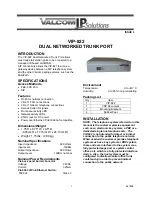
Responder time responder
U
SER
G
UIDE
353
It executes the command supplied as argument it the specified probe operation fails, i.e. when no
reply is received for a number of times equal to the value specified as
threshold
.
set rtr reaction-event ifSuccess <command>
It executes the command when the probe receives a reply.
set rtr reaction-event ifFailureAfterSuccess <command>
It executes the command when the probe fails but it had received a reply before.
set rtr reaction-event ifSuccessAfterFailure <command>
It executes the command when the probe is successful, but it had previously failed.
In order to specify a list of commands the following command is repeated:
set rtr reaction-event
The execution of commands follows the sequence according to which they have been inserted.
The command:
set rtr start-time immediately
activates the probe immediately.
set rtr start-time in N
It activates the probe within an interval of time not lower than N seconds.
It is possible to configure with the same syntax up to a maximum of 4 RTR: RTR, RTR1, RTR2, RTR3.
D
ISPLAYING SERVICE STATUS AND STATISTICS
In order to display the RTR the command is:
show rtr config|status|statistics
By specifying the argument
config
the configuration of the RTR service is displayed as follows:
root@Imola>
show rtr config
set rtr frequency 60
set rtr timeout 5000
set rtr interval 500
set rtr pkt-size 32
set rtr pkt-num 10
set rtr lifetime 3600
set rtr threshold 3000
set rtr start-time in 30
set rtr no-tos
set rtr responder-type standard
set rtr off
By specifying the argument
statistics
,
statistics of the RTR are displayed as follows:
timestamp at the start of service
number of probe messages sent
number of probe messages received
















































